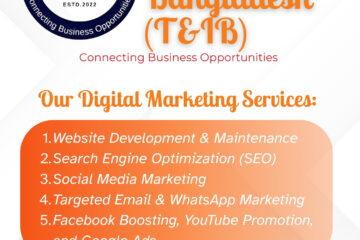How Light Engineering Became the Mother of Heavy Industry?
Md. Joynal Abdin*
Business Consultant & Digital Marketer
Co-Founder & CEO of Trade & Investment Bangladesh
Introduction
In the annals of industrial history, the transformative interplay between light engineering and heavy industry stands as a testament to the evolution of human innovation. At the heart of this narrative lies the intricate dance between precision and power, as light engineering, often hailed as the more delicate and nuanced sibling, emerges as the unsuspecting catalyst for the formidable rise of heavy industry.
Defining the Terms: Light Engineering and Heavy Industry
Light engineering, characterized by its focus on precision, intricacy, and the development of specialized technologies, has historically been associated with fields such as optics, mechanics, and early electrical engineering. In contrast, heavy industry represents the formidable realm of manufacturing and production involving massive machinery and complex processes. This dichotomy, seemingly disparate, becomes the focal point of our exploration as we delve into the historical corridors of industrial development.
The Industrial Revolution: A Crucible of Innovation
To comprehend the symbiotic relationship between light engineering and heavy industry, we must first traverse the landscape of the Industrial Revolution. In the late 18th and early 19th centuries, a seismic shift occurred, marking the transition from agrarian economies to industrial powerhouses. Factories replaced workshops, steam engines supplanted manual labor, and technological advancements reshaped the very fabric of society. It was within this crucible of innovation that the synergy between precision and power began to emerge.
Central Thesis: Light Engineering as the Catalyst
Our central thesis propels us into an exploration of how light engineering, often regarded as the mother of heavy industry, served as the driving force behind the metamorphosis of manufacturing landscapes. This inquiry invites us to dissect the intricate connections between early advancements in optics, mechanics, and precision tools and the subsequent birth and exponential growth of heavy industry.
Join us on this historical odyssey as we unravel the nuanced tapestry of technological evolution, where the delicate intricacies of light engineering forge an indelible path, ultimately giving birth to the juggernaut that is heavy industry. In this exploration, we seek to understand not only the past but also the enduring legacy of this dynamic relationship, as it continues to shape the technological landscape of the present and, undoubtedly, the future.
The Birth of Light Engineering
In the corridors of technological history, the genesis of light engineering can be traced back to a fascinating tapestry of inventive minds, pioneering spirit, and groundbreaking discoveries. The roots of light engineering delve into a realm where precision and ingenuity coalesce, setting the stage for advancements that would forever alter the trajectory of industrial development.
Mechanics: The Mechanical Foundations
At its embryonic stage, light engineering found its foothold in the realm of mechanics, where inventors and engineers sought to unravel the mysteries of motion and machinery. The advent of precision instruments, such as clocks and gears, marked a crucial juncture. The quest for accuracy in measuring time and motion laid the groundwork for a discipline that would soon burgeon into the intricate realm of light engineering.
Optics: Unveiling the Secrets of Light
Simultaneously, the study of optics emerged as a cornerstone in the evolution of light engineering. Pioneers like Ibn al-Haytham, often hailed as the “father of optics,” delved into the behavior of light, laying down foundational principles that would become instrumental in the design of lenses, telescopes, and microscopes. The ability to manipulate light with precision opened new vistas, not only in scientific exploration but also in the realm of burgeoning technologies.
Materials: Crafting the Foundations
As the wheels of progress turned, the materials used in engineering became crucial contributors to the burgeoning field of light engineering. Innovations in metallurgy and the development of specialized alloys played a pivotal role. The crafting of materials with specific properties, such as durability and malleability, became essential in creating the delicate yet robust components that characterized light engineering devices.
The Crossroads: Confluence of Disciplines
In the crucible of technological advancement, the 18th and 19th centuries witnessed a confluence of these disciplines. Precision mechanics, optical insights, and advanced materials converged, giving rise to a new era of engineering where meticulous craftsmanship and scientific understanding became inseparable.
The telescope, with its precision lenses and finely tuned mechanics, epitomized this fusion. Innovations in the manufacturing of telescopic lenses showcased the intricate dance between mechanics and optics, a dance that would set the stage for the burgeoning field of light engineering.
In this pivotal juncture, the birth of light engineering was marked by a harmonious blend of mechanical finesse, optical acumen, and material craftsmanship. This historical backdrop serves as the canvas upon which the narrative of light engineering unfolds, setting the stage for its unforeseen role as the linchpin in the emergence and growth of heavy industry.
Catalytic Innovations
The narrative of light engineering unfolds not merely as a chronicle of incremental advancements but as a tale marked by catalytic innovations that propelled societies into new epochs of technological prowess. These breakthroughs, ranging from the ingenious application of steam power to the refinement of precision tools and the advent of electrical components, stand as beacons of transformation, forever altering the landscape of industry and engineering.
The Steam Engine: Powering Progress
Among the most pivotal breakthroughs in light engineering was the harnessing of steam power. The steam engine, with its ability to convert heat into mechanical energy, revolutionized manufacturing processes and transportation. In the late 18th century, inventors like James Watt refined the steam engine, allowing for a more efficient and reliable source of power. This innovation had a profound impact, transcending the confines of light engineering to become the driving force behind heavy industry. Factories, ships, and railways, powered by steam, heralded an era of unprecedented productivity and connectivity.
Precision Tools: Crafting Perfection
The refinement of precision tools emerged as another catalyst in the evolution of light engineering. Innovations in the crafting of intricate instruments, such as lathes and measuring devices, enabled engineers to achieve unparalleled accuracy in their work. The precision afforded by these tools not only elevated the quality of light engineering products but also played a crucial role in the production of more complex machinery within heavy industry. The marriage of precision and power became a hallmark of technological progress.
Electrical Components: Illuminating the Future
As the 19th century unfolded, a new player entered the stage of light engineering – electricity. The development of electrical components, from generators to motors and lighting systems, marked a paradigm shift. Innovators like Thomas Edison and Nikola Tesla, with their groundbreaking work, demonstrated how electrical engineering could be seamlessly integrated into the fabric of industry. The transformative impact of electricity went beyond illumination; it powered machinery, enhanced efficiency, and laid the groundwork for the electrification of heavy industry.
In this era of catalytic innovation, light engineering ceased to be confined to the delicate intricacies of optics and mechanics. It became a dynamic force, shaping the very essence of industrial progress. The steam engine, precision tools, and electrical components emerged as the vanguards of change, propelling both light and heavy engineering into a future where precision and power were no longer mutually exclusive. These breakthroughs laid the foundation for a technological revolution that continues to resonate in the intricate machinery and systems that define our contemporary industrial landscape.
From Light to Heavy: Evolutionary Links
The journey from the delicate intricacies of light engineering to the formidable realm of heavy industry represents not just a transition, but a natural and symbiotic evolution fueled by the continuous interplay of precision and power. As advancements in light engineering technologies unfolded, they seamlessly wove themselves into the fabric of industrial progress, laying the foundations for the birth and growth of heavier machinery and more complex manufacturing processes.
Precision Becomes Power: The Pivotal Shift
At the heart of the natural progression lies the realization that precision, once the defining characteristic of light engineering, could be harnessed to wield immense power. The precision achieved in the crafting of tools, gears, and mechanisms within light engineering seamlessly extended its reach to the development of more substantial machinery. This shift was not merely quantitative but qualitative, as the meticulous craftsmanship that characterized light engineering found new expression in the creation of heavy-duty equipment.
Scaling Up: Machinery and Manufacturing
Advancements in light engineering technologies enabled engineers to explore the scalability of precision. The same principles applied in crafting delicate instruments could now be extrapolated to construct larger and more robust machinery. The intricate gears designed for precision instruments found resonance in the colossal gears of industrial machinery. As the demand for increased productivity and efficiency grew, light engineering principles were reimagined on a grander scale, giving rise to heavy machinery capable of mass production.
Optimizing Processes: Efficiency in Heavy Industry
The meticulous optimization of processes, a hallmark of light engineering, became a guiding principle in heavy industry. The precision tools that once shaped small components were now adapted to manufacture intricate parts for heavy machinery. Each innovation in light engineering, from improved materials to more accurate measurement techniques, found applications in heavy industry, streamlining manufacturing processes and enhancing overall efficiency.
Technological Synergy: A Unified Approach
The natural progression from light engineering to heavy industry was marked by a merging of disciplines. Engineers and inventors began to recognize that the delicate touch of precision could coexist with the brute force required for heavy machinery. This technological synergy manifested in the design of machines that combined precision components with robust structures, ensuring not only accuracy but also durability in the demanding environment of heavy industry.
A Legacy of Innovation: Shaping Modern Industry
The legacy of this natural progression is evident in the seamless integration of light engineering principles into the very DNA of modern heavy industry. Today, the sophisticated machinery powering manufacturing plants bears the unmistakable imprint of precision and intricacy that were once the hallmarks of light engineering. The journey from crafting precision instruments to building heavy machinery represents not only a chronological evolution but a testament to the enduring synergy between precision and power in the annals of industrial progress.
Industrial Revolution Unleashed
The integration of light engineering into various industries has been nothing short of revolutionary, casting a wide-reaching influence on the fabric of society and the contours of the global economy. As precision and finesse became integral components of industrial processes, the ripple effects extended far beyond manufacturing plants and workshops, ushering in profound societal and economic changes.
5.1 Precision Revolutionizes Production:
The infusion of light engineering principles into manufacturing processes marked a precision revolution. Industries witnessed a paradigm shift from traditional, labor-intensive methods to highly accurate and efficient production lines. The meticulous craftsmanship inherent in light engineering translated into the mass production of goods with unprecedented quality, setting new standards across diverse sectors.
5.2 Rise of Specialization:
The precision demanded by light engineering necessitated specialization. As industries incorporated specialized tools and technologies, a surge in expertise and niche skills ensued. This shift towards specialization not only elevated the proficiency of workers but also paved the way for the emergence of new job roles and professions, fostering a more skilled and diversified workforce.
5.3 Technological Advancement Spurs Innovation:
The integration of light engineering fueled a relentless drive for technological advancement. Innovations in materials, machinery, and processes became a hallmark of industries influenced by light engineering principles. This culture of innovation extended beyond the engineering realm, impacting fields such as research, development, and design, shaping a landscape where progress became synonymous with adaptability and technological prowess.
5.4 Economic Growth and Globalization:
The precision and efficiency introduced by light engineering played a pivotal role in propelling economic growth. Industries, now capable of producing goods at an unprecedented pace and scale, fueled economic expansion. Furthermore, the integration of light engineering into manufacturing processes contributed to the globalization of industries, as goods could be produced and distributed on a global scale, reshaping trade patterns and economic interconnectedness.
5.5 Improved Quality of Life:
As industries harnessed the precision and efficiency of light engineering, the quality of products improved, leading to enhanced standards of living. From consumer electronics to medical devices, the application of light engineering principles resulted in the development of goods that were not only more affordable but also of superior quality, contributing to an overall improvement in the quality of life for many.
5.6 Environmental Impacts:
The integration of light engineering also had environmental implications. Efficiency improvements in manufacturing processes, driven by light engineering principles, contributed to resource conservation and waste reduction. Sustainable practices, often rooted in precision and optimization, became a focal point as industries adapted to environmental concerns, marking a shift towards more eco-friendly production methods.
5.7 Job Evolution and Skill Demands:
The integration of light engineering altered the employment landscape, demanding a shift in skill sets. Traditional manual labor gave way to roles requiring technical expertise and proficiency in operating advanced machinery. The demand for skilled engineers, technicians, and specialists increased, reflecting a societal shift in the types of skills deemed essential in the modern industrial era.
In conclusion, the broader impact of light engineering on the industrial landscape is not confined to the production floor; it extends into the very fabric of society and the dynamics of the global economy. As industries embraced precision, innovation, and efficiency, the resulting societal and economic transformations became emblematic of a new era where the marriage of technology and craftsmanship reshaped the world as we knew it.
To read the 2nd part of this article, Click Here!
How Light Engineering Became the Mother of Heavy Industry?
Mr. Md. Joynal Abdin is a Business Consultant & Digital Marketer based in Dhaka, Bangladesh. He is Founder & CEO, Trade & Investment Bangladesh and Co-Founder & CEO of Bangladesh Trade Center. Previously he served at Dhaka Chamber of Commerce & Industry (DCCI) as Executive Secretary; DCCI Business Institute (DBI) as Executive Director; SME Foundation as Deputy Manager; and the Federation of Bangladesh Chambers of Commerce & Industry (FBCCI) as Assistant Secretary.
The list of services Mr. Abdin is offering includes but not limited to Business Mentorship, Business Research and Documentations, Export Market Selection and Product Positioning at Home and Abroad; Buyers-Sellers Matchmaking; Website Development; Search Engine Optimization (SEO); and Social Media Marketing etc.






0 Comments